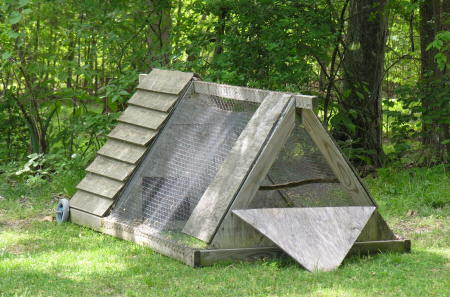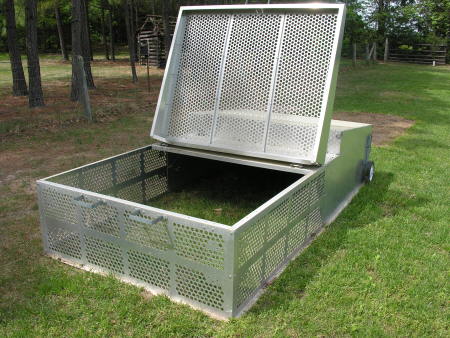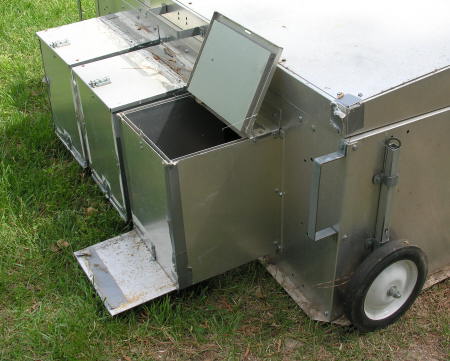Prior to buying the ranch we are at, Retta and I took the opportunity to visit the property several times, doing the due-diligence inspections all property purchasers should undertake (including, I should note, the all important survey). During these visits, we noticed, behind the former milking barn, an odd looking contraption, half-buried amongst the odds and ends that always seems to accumulate behind old milking barns. As neither of us recognized what this object was, it soon disappeared into the deepest recesses of our memory banks. On our last visit prior to closing escrow, while watching television at the Comfort Inn we were staying at, we saw an episode of the P. Allen Smith gardening show.  One particular segment of the show featured something called a chicken tractor. And what the show portrayed on the screen looked very similar to the contraption sitting behind the milking barn. Now we knew what that thing was – a chicken tractor. I had previously heard of lawn tractors, garden tractors, farm tractors, and even tractor-trailers, but I had never heard of a chicken tractor!Â
When Retta and I found that we had become the proud owners of chickens (see previous post), we faced the problem of deciding where to house them, and we needed to learn the basics of caring for them. While looking for information at the local farm store, we ran across a book entitled “Chicken Tractor – The Permaculture Guide to Happy Hens and Healthy Soil”. That caught my attention instantly, as I never want to be accused of having unhealthy soil, and heaven forbid, unhappy chickens!  Consequently, I purchased that book and learned everything one could possibly know about chicken tractors. Everything.  Including the information I shall now share with you. First, here is what one chicken tractor looks like:

From this picture you can see that this tractor has an enclosed shelter area, which includes a nesting box elevated off the ground. There is also an outside pen. Both areas of the tractor are exposed to the ground. Here is how the chicken tractor is operated. Put the chickens inside. Close the door. Feed and water the chickens daily. Move the tractor daily. Clean out the nesting box periodically. And that is all there is to it.
There are several advantages to utilizing a chicken tractor to house your fowl. Because the chickens have access to your lawn at all times, they will help control insect populations. The chicken droppings will help fertilize the lawn. Most important, the chicken tractor should protect your birds from predators.
There are disadvantages to the chicken tractor as well. The tractor has to be heavy enough to stay put in heavy winds. The weight makes it difficult to move unless it is designed with an efficient wheel mechanism (which the one above does not have). In the photograph below, you can see another type of chicken tractor. This is a commercial chicken tractor, manufactured in Missouri, that is designed to be both lightweight and strong.

In this style of chicken tractor, the lighter weight is offset by the improved stability that the low, wide profile provides. Varmints cannot overturn a tractor of this type, and it’s light weight make it fairly easy to move around your lawn. In the following photograph, you can see the design of the three nesting boxes that are a part of this tractor. The boxes have exterior lids, making it easy to collect eggs and add litter. The slide-out floor at the bottom allows for easy litter removal.

Now for the bad news about chicken tractors. The biggest drawback to the use of a chicken tractor is that, no matter how heavy and sturdy you construct it, varmints can burrow into it easily, simply by digging a hole in the ground anywhere along it’s sides. We once lost a whole batch of chickens in one night alone, after some unknown critter dug its way underneath the sides of the tractor.
We now utilize permanent coops for our fowl, with concrete footings at the base. This prevents critters from taking the underground route to our birds. And what has become of our two chicken tractors? The wooden tractor has become an infirmary and isolation ward for any bird that might happen to need that type of TLC. And the aluminum chicken tractor is just the right size to store a pickup-truck size load of trash. When it fills up with trash bags, I load the truck and take it over to the county transfer station to dispose of it. But that is another story.



I came across your name on Pure Florida and stopped over, only to find this interesting post on chicken tractors. We have been thinking about building one as the kids have my hen coop full of rabbits and I have to clamber up into an old corn crib to steal an egg if I want one. I was glad to read the pros and cons of the device and to see some clear pictures. Thanks
Nice blog!
I’ve been reading some about chicken tractors and by far this is the best article on the subject matter. Now I know what I’m up against.
As far as the other story, I’ve been trying to figure out what to do with our trash. I’ve set up weekly service just like in the city (except it’s an old boy with a pickup instead of a commercial trash truck) but I’m wondering what to do with the trash during the week. I need to create some sort of enclosure to store the bags in until trash day. I was thinking of keeping the enclosure at the end of the driveway and just dropping off the previous night’s trash on the way to work in the morning.
We had a weekly trash service for a while. They even used real trash trucks. We are back at the end of a two mile dirt lane that leads to the paved highway, where the trash company would pick up our trash. There are houses on either side of this lane at the highway, so consequently there is nowhere for us to put any kind of bin there. So we used heavy-duty trash bags, and I would haul them to the highway for pickup every Tuesday morning.
Eventually, neighbors’ dogs, stray dogs, and other critters started ransacking the trash bags. I got tired of having to pick up a week’s worth of trash along the highway, so I ended up just dropping the commercial trash service. Our county charges $32.10/year for a permit which allows you to drop off trash and recyclables at the county transfer station, so that is now part of my routine.
LOGIC QUIZ – how did the county come up with a figure like $32.10?
I have no idea… Sounds like a good subject of another post!
> LOGIC QUIZ – how did the county come up with a figure like $32.10?
Probably with the same formula that yields the $299 fine for roadside littering.
> LOGIC QUIZ –
2006 Fee = $32.10 = F + (.07 F) where F=2005 Fee
And they say inflation is under control!
MrC – RE: $299 fine for roadside littering.
When we moved to Arkansas in 2000 the fine for littering was $100. There was lots of litter on the side of the roads. In an attempt to reduce roadside litter, the state upped the fine to $1000 in 2002 (I think my recollection as to dates is correct, but it is irrelevant to the story anyway). Revenue from litter fines dropped precipitously, but the roadside litter continued. What was going on here? Everyone thought the revenue would increase from the fines and that the litter would go down.
It turned out that local law enforcement was reluctant to issue citations for littering anymore, since the financial penalty was quite high (particularly for Arkansas, where incomes are relatively low). So even though the fine increased tenfold, revenues from the fines plunged. Is there a moral to this story? Yes – the law of unintended consequences never rests.
POSTSCRIPT – The state legislature reduced the littering fine back down to the original $100 amount in 2005. And road crews all over the state had to replace thousands of roadside littering signs for the second time in a couple of years. And most unfortunately, the roadside litter continues.
Very interesting! I used to see the $299 fines throughout the southwest on roadtrips. I always envisioned policiticians and legislators sitting in back rooms pretending to be sales and marketing execs, fooling themselves into believing the public would be dupped with the just-under $300 strategy. Litter fine? High 200’s.
Of course, that’s the more sinister side of my brain. The other side says, the number was carefully chosen to disturb and forever haunt folks like me. 🙂
> Logic Quiz
F = $30. So, by the rule of 7 & 10, the fine will double in 10 years, so its better to toss your garbage on the road today vs. tomorrow!
In B-school I learned the “rule of 72”, best applied to annually compounded quantities, which means the fine would double in 10.286 years. The rule of 7 & 10 (or rule of 70) is better left for continuously compounded quantities. Unless your backroom politicians convene daily to readjust littering fines, we should probably use the rule of 72. Don’t rush things!
Ditto on the pros and cons of chicken tractors. I still use my homemade one, but I have to keep it in dog distance of the house…too far from the porch (dog haven) and the raccoons may dig into it. Also, they can’t sit in one place in the yard for long or the high N content of chicken feces will kill instead of nurture lawn grass.
I have the same book…kind of a fun read. My chicken tractor looks like this…
http://pureflorida.blogspot.com/2005/06/i-spent-this-evening-mounting-old-pair.html
Marrianne, if you visit Pureflorida, leave a comment sometime.
Great blog Hal.
Okay, I just realized who Marianne is. Sorry 3C, didn’t recognize ya’.
It occurs to me that if you make the chicken tractor out of pig iron, it might just be heavy enough to act as a rock finder. The leading edge will pull those bad boys right out of the ground!
One problem with the wooden chicken tractor pictured above is it’s heavy weight – it feels as if it is constructed of pig iron! Even with wheels, Retta had a difficult time moving it around. And as FC points out, they MUST be moved frequently.
Pingback: Ranch Ramblins » Blog Archive » The County Transfer Station
I think the chicken tractor is a fantastic idea and think a few mods would make it fool-proof. What if there was a solar powered eletric wire insulated from the main coop area that ran along the base of the coop. Wouldn’t this prevent predator dig-ins?
This comes a little late, but I just found this while web surfing. I’ve discovered an easy way to deter creatures from digging into a tractor. Attach hardware cloth (aka rat wire) to the base of the tractor all around the outside of it. It folds up easily when moving the tractor, and since predators only dig right at the base of the pen, they hit the wire and can’t get in. If they ever figure out to dig a foot and a half AWAY from the pen to start tunneling, then we’re in trouble.
Interesting info on the tractors and I can see I’ve shared much of the same experiences. Used a dog run, added wheels and laying boxes, then Closet-made shelving pieces around the outside similar to TK(held in place with the brackets and bent up a bit at the corners to ‘ride’ over the grass). The took a wheeled trailer mover and used it to lever up the front end and pull it around on the two wheels in the back. Problem was the chickens took to digging in the sandy soil for dust baths and pretty soon the area was cratered with depressions that made it nearly impossible to pull this monstrosity around. The chickens went into a fixed coop for the winter and I’ll need to make a smaller, lighter tractor for this spring/summer. I intend to build a connector to the coop with a sliding door. I’ll return the tractor to the coop at night, remove the door and when they go up to roost, just replace the door, sealing it off. Then I don’t care if the critters dig under it. In the morning, I’ll move the feed into the tractor and when they’re in place, just drag it out to the garden. Lather, rinse, repeat 3-4 times a week to fertilize, feed them grass, and keep the pests down…Must admit I’m jealous of that expensive trash bin. What I wouldn’t give for something that well made…in eggs of course.
Ha, nice thing. Haven’t heard about it.
Would you like to sell your aluminum chicken tractor?
What is the name of the company that manufactures the metal chicken tractor ? Could you please e mail me the name ? Thanks and enjoyed article.
Ed – You can find these chicken tractors at Easy-Garden
I would love the aluminum chicken cage